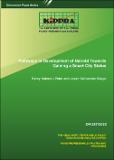| dc.description.abstract | Countries worldwide are actively pursuing smart city development, employing various methods to assess and prioritize policy areas. This study focuses on evaluating smart development in Nairobi City using the Analytic Hierarchy Process (AHP) with 38 indicators across six dimensions: people, living, mobility, economy, governance, and environment. The findings reveal that Nairobi exhibits normal smart growth with an overall growth rate of 18.64%. The dimensions are ranked as follows, from highest to lowest: living, people, mobility, economy, governance, and environment. Key indicators in each dimension include installed learner digital devices in primary schools (people), percentage of households connected to fixed broadband (mobility), number of hospital facilities per 10,000 population (living), number of tech hubs (economy), number of city services accessible via web or mobile (governance), and percentage of renewable energy in electricity generation (environment). All dimensions are vital for achieving smart city growth, and their interconnection is crucial. To leverage the highly ranked indicators, actions should focus on empowering the workforce, accelerating the Digital Literacy Programme, improving health infrastructure, enhancing digital infrastructure, adopting electric vehicles, promoting youth innovation, implementing e-voting technology, and strengthening solid waste management. | en |

